The concept of marketplaces isn’t new. In fact, they’re prevalent in our everyday lives. Companies like Uber, Airbnb and Zillow have changed how we get around, plan vacations and buy homes. Behind these experiences are marketplaces that connect people willing to provide a service to consumers in need, and they have become an essential part of the many different decisions we make.
This same marketplace pervasiveness has transcended enterprise SaaS and B2B sales, and has transformed how buyers discover enterprise technologies. Called cloud marketplaces, this new and increasingly popular channel enables brands to digitally procure innovative technologies. And it’s a trend that’s taking off. Forrester estimates that by 2023, 17% of the $13 trillion U.S. B2B procurement market will be transacted online.
For startups, the benefits of being part of cloud marketplaces such as Amazon’s AWS Marketplace, Google Cloud Marketplace and Microsoft Azure Marketplace are huge. Those that leverage this emerging channel can:
- Close larger deals
- Shorten sales cycles
- Reduce the complexity of navigating customer procurement processes
Cloud marketplaces are also an attractive option for large enterprises with existing relationships with cloud vendors. Companies that turn to cloud marketplaces for new technologies benefit by:
- Being assured that startups have met a certain level of security standards required by the cloud marketplace provider
- Knowing they can retire the purchase value for startup technologies against their annual cloud spend commitments
- Experiencing a much simpler procurement process, which standardizes contracts for buyers and sellers of software on the marketplace’s terms and agreements
The next wave of software sales is being heavily influenced by the rise of cloud marketplaces as large enterprises leverage them as part of their broader cloud IT procurement strategy. While the benefits of cloud marketplaces can be enormous, it’s a nascent channel for most startups and their revenue leaders.
To help CEOs and go-to-market (GTM) leaders navigate and identify ways to leverage cloud marketplaces, we created The Startup’s Guide to Cloud Marketplaces eBook. In interviewing over 20 alliance executives from companies such as MongoDB, Snowflake and Sumo Logic, as well as cloud executives from AWS Marketplace, Google Cloud Marketplace and Microsoft our goal is to help startups:
- Decide whether their company should sell through a cloud marketplace
- Determine which cloud marketplace(s) to sell-through
- Demystify facts from fiction regarding cloud marketplaces
- Provide best practices on how to sell via cloud marketplaces effectively
Please reach out with any questions: [email protected].




